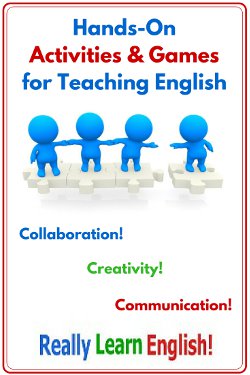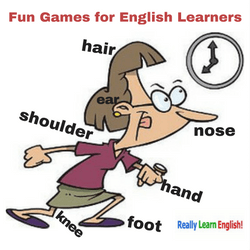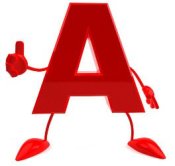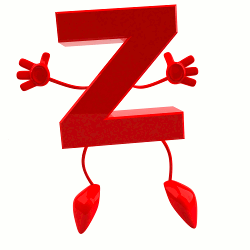More Hands-on Activities and Games for Teaching English
Students learn in a variety of ways, so it is important to teach using multiple methods. Teaching English with hands-on activities and games can help language students learn and practice new vocabulary, grammar, ideas, and concepts.

Hands-on activities and classroom games encourage creativity, communication, and collaboration. If students are working with partners or in small teams, they have to collaborate and communicate to complete the task. Students can practice their English speaking skills.
Click Here for Step-by-Step Rules, Stories and Exercises to Practice All English Tenses
In our first article in this series, we described seven activities to
engage your students in learning English. You can read that article
here: Hands-on Activities for Teaching English.
Incorporating hands-on activities into
your lesson
plans is key to
reaching a variety of students.
Here are seven more simple activities and games to get students moving
and learning in the English classroom. These activities can be used by
teachers, parents, tutors, study groups, and home-school teachers to help English
language students learn and practice new vocabulary,
grammar,
and
comprehension.
Parts of the body
This is an easy game for reviewing parts of the body in English.The class will be divided into small groups of three to four students. Before class, make sets of word cards using note cards or sticky notes. Write one body part on each card. Make one set for each group. If you use note cards, you will also need tape for each group.
Divide your class into small groups of three or four students. Each group gets one set of cards. One student in the group is the model, and the other group members will attach cards to the correct body part of the model. Set the timer for about 5 minutes. When the time starts, the other group members stick the cards to the correct body part on the model.

When time is up, the teacher can check cards for each group. Read all of the cards out loud and award one point for each correct answer. Students enjoy this activity, and there will be lots of laughs!
Move to music
This is a great way to get students
out of their chairs and communicating. Teachers can use this activity
with any topic and at any time with little preparation.

The instructions are simple. When the music begins, the students get up and randomly walk around the classroom. When
the music stops, students turn to their nearest classmate to discuss a
topic or answer.
I like to use this activity with discussion questions. I ask a
question, then turn on the music. As students are walking, they can
think about their answer. When the music stops, they find their partner
and discuss the answer.
This is also a great icebreaker activity for a new class. When the
music stops, students take turns introducing themselves and answering
questions given by the teacher.
Sound chain / Phonic chain
This is an easy way to review phonics
and letter sounds. The whole class sits in a circle. One student says a
word. The next student must say a word that starts with the last sound
of the previous word. To make this more difficult, choose a topic or
category for all the words: boy’s names, animals, things found in a
classroom, etc.
Example
Topic: things found in a kitchen

Student 1: knife (ends with f sound)
Student 2: food (begins with f sound; ends with d sound)
Student 3: drinks (begins with d sound; ends with s sound)
Student 4: soap (begins with s sound; ends with p sound)
Student 5: pan (begins with p sound; ends with n sound)
Continue around the circle until everyone has contributed or until you
run out of words. For a variation, you could eliminate students when
they can’t think of a word and the final student playing is the winner.
Scoring is optional.
Twenty questions

The class asks the player questions that can be answered with "yes", "no", "sometimes", or "I don’t know." Students can guess the mystery object at any time, but that counts as one of the 20 questions. The winner is the student who correctly guesses the object, or if nobody correctly guesses, then the player wins.
The traveling game
This activity is a fun way to review
vocabulary and the alphabet while practicing sentences. This game is
known by many names including "the shopping game," "I took my basket
shopping," "I packed my suitcase," and "camping trip." You can use any
version of this game to review vocabulary in many topics. The words don't necessarily have to make sense with the category.

Player 1: I’m taking a trip, and I’m going to pack an apple.
Player 2: I’m taking a trip, and I’m going to pack an apple and a book.
Player 3: I’m taking a trip, and I’m going to pack an apple, a book,
and a cap.
Player 4: I’m taking a trip, and I’m going to pack an apple, a book, a
cap, and deodorant.
Continue around the circle, using the entire alphabet.


For variations, use sentences in different tenses and different subjects.
-
Yesterday, I went shopping and bought a…
- Tomorrow, I will go shopping, and I will buy…
- Last year, I traveled to Australia and brought back…
Fun with synonyms: guess the word
Use this activity to review vocabulary and practice synonyms. Give each students note cards or sticky notes and 1-3 vocabulary words from the unit you wish to review. Students must write down the word and 4-5 synonyms on the card.Then, students will read the synonyms on their cards, and the rest of the class will guess the vocabulary word. For a variation, the teacher can read the synonyms and students can write the vocabulary word, or you can play in teams. As the teacher reads the synonyms, the first team to buzz in and answer with the correct word wins a point!
Examples:
Teacher professor educator instructor tutor |
House home residence dwelling homestead |
Vocabulary Bingo
Bingo is an easy and fun way to review vocabulary and can be used with any topic. You can find printable blank Bingo boards online or have your students draw their own (usually 5 squares X 5 squares but can be any size you wish).Give your students a list of vocabulary words. They use the words to fill in their Bingo boards, leaving one or two free spaces (not in the same row).
| B | I | N | G | O |
| foot | hand | knee | shoulder | toes |
| fingers | palm | toenail | nose | ears |
| hair | tongue | FREE | eyes | forehead |
| stomach | back | elbow | arm | lips |
| fingernail | beard | ankle | shin | cheek |
You will also need markers. If you plan to re-use boards, students can use small objects such as candy, pennies, or dried beans as markers. If the boards are only used one time, students can mark the words with a pen or pencil.
After the Bingo boards are completed, the teacher reads definitions for vocabulary words as the students cover the correct word with a marker. The first student to complete an entire row (vertical, horizontal, or diagonal), yells, "Bingo" and wins. You can continue to play until more students win or start over.
This game could also be combined with Fun with Synonyms after students create their synonym cards.
Get Updates, Special Offers, and English Resources
Download your FREE GIFT (the first two chapters of
English Short Stories Book and Workbook)
as soon as you join!

By submitting your email, you consent to receiving updates and newsletters from us and to the sharing of your personal data with third parties for the purposes of sending you communications. We will not spam you. You can unsubscribe at any time. For more information, please see our privacy policy.
Return from More Hands-on Activities and Games for Teaching English to
How to Teach English





